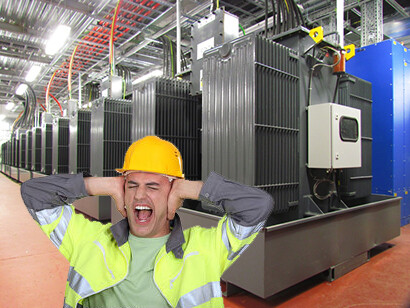
All transformers have an inherent sound level that varies with the size and style of the core/coil assembly. Depending on the transformer operating conditions, sound level measurements at the installation site can be drastically different than those taken at the factory.
While transformer cores are generally recognized as the main source of transformer sound, electromagnetic forces in the windings, known as load noise, can also be a significant influence in low sound level transformers, among other electrical and mechanical factors.
Therefore, the sound-producing mechanisms of transformers can be characterized as follows:
1. Core Sound
When a strip of iron is magnetized, a phenomenon known as magnetostriction occurs, causing the iron to change its physical dimensions. When the magnetization is removed, the iron strip returns to its original condition and shape. This change in physical dimension is usually only a few parts in a million.
Transformer cores are constructed by stacking layers of thin iron laminations, separated from their neighbors by a thin non-conducting layer of insulation. When the core becomes magnetized, the magnetic field acts between the adjacent plates, stretching and squeezing the adhesive and insulation between them.
Related: Types and Construction of Power and Distribution Transformers
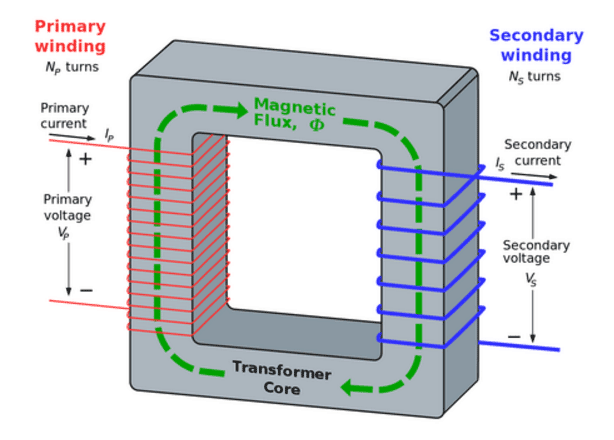
A transformer is magnetically excited by an alternating voltage and current so that it becomes extended and contracted twice during a full cycle of magnetization. Photo: Wikimedia.
A transformer is magnetically excited by an alternating voltage and current so that it becomes extended and contracted twice during a full cycle of magnetization. This change in dimension is independent of the direction of magnetic flux, occurring at twice the line frequency.
Why do transformers get louder as they age?
Over time, the transformer core adhesive starts to break apart, and the laminated layers separate from each other slightly. The vibration of these layers is the humming noise you can hear, and once the adhesive starts to break, the sound gets louder.
Flux density, core material, core geometry, and the waveform of excitation voltage are the factors that influence the magnitude and frequency components of the transformer core sound levels. Because the magnetostriction curve is nonlinear, higher even harmonics also appear in the resulting core vibration at higher induction levels.
The low-frequency, tonal nature of transformer core noise makes it harder to eliminate than the higher-frequency noise that comes from other sources. This is because low frequencies travel farther with less attenuation.
2. Load Sound
In transformers, the load noise is predominantly produced by axial and radial vibration of the windings. Load noise can also be caused by vibrations in the transformer tank walls and magnetic shields due to the electromagnetic forces produced by the load currents. These electromagnetic forces are proportional to the square of the load currents.
The frequency of load noise is usually twice the power frequency. In some cases, the natural mechanical frequency of winding clamping systems may tend to resonate with electromagnetic forces, thereby severely intensifying the load noise.
The presence of harmonics in load current and voltage (e.g., in rectifier transformers) can produce vibrations at twice the harmonic frequencies and thus a sizable increase in the overall sound level of a transformer.
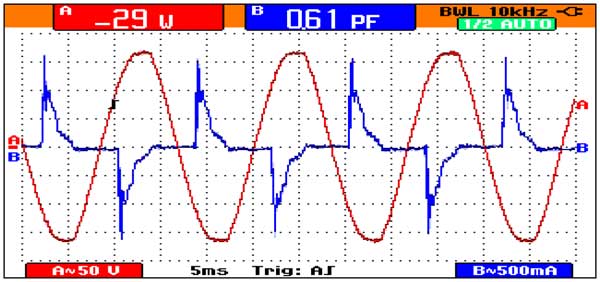
Harmonics in load current and voltage can produce vibrations at twice the harmonic frequencies in transformers. Photo: Wikimedia.
The magnitude and the phase angle of the load currents also change the internal voltage drop in the transformer windings. The transformer loading conditions, therefore, can change the core induction level and significantly influence the core sound levels.
Harmonic content in the load current has a larger impact on the sound level than might be expected from the amplitude of the harmonic currents since they interact with the power frequency load current. Current harmonics are a major source of an increase in sound levels in HVDC and rectifier transformers. Nonlinear loads cause harmonics in the excitation voltage, resulting in an increase in core sound levels.
Related: Power Quality Analysis: Basic Theory and Applications Explained
3. Fan and Pump Sound
The main source of heat generation in power transformers is caused by copper loss in the windings and core (I2R losses). This heat is often removed by cooling fans that blow air over radiators or coolers. Noise produced by cooling fans usually contributes more to the total noise for transformers of smaller rating and for low-induction transformers.
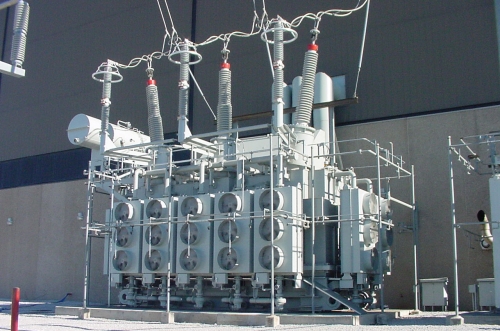
Transformer heat is often removed by cooling fans which blow air over radiators. Photo: Wikimedia.
Factors that affect the total fan noise output of a transformer include:
- tip speed
- blade design
- number of fans
- the arrangement of the radiators
Cooling equipment noise typically dominates the very low and very high-frequency ends of the sound spectrum, whereas the core noise dominates in the intermediate range of frequencies between 100 Hz and 600 Hz.
Related: Transformer Cooling Systems and Methods Explained
4. Mechanical and Structural Sound
The mechanical resonance in the transformer mounting structure, core, and tank walls can have a significant influence on the magnitude of transformer vibrations and, consequently, on the acoustic noise generated. Marginally designed magnetic shielding can also be a significant source of sound in transformers.
5. Sound caused by DC Magnetization
Even a moderate DC magnetization of a transformer core will result in a significant increase in the transformer audible sound level. In addition to increasing the power level of the normal harmonics in the transformer vibrations (i.e., even harmonics of the power frequencies), DC magnetization will add odd harmonic tones to the overall sound level of the transformer.
Modern cores have a high remnant flux density. Upon energization, the core sound levels may be as much as 20 dB higher than the factory test value. It is, therefore, recommended that a transformer should be energized for approximately six hours before evaluating its sound levels.
Traditionally, circuits like DC feeders to transportation systems have been a source of DC fields in transformers. However, with the increased use of power electronic equipment in power transmission systems and in the industry, the number of possible sources for DC magnetization is increasing. Geomagnetic storms may also cause severe DC magnetization in transformers connected to long transmission lines.
6. Acoustical Resonance
Sound propagation is affected by many factors, such as atmospheric absorption, intervening barriers, and reflective surfaces. Sound waves may be amplified by means of reflected waves and/or radiated waves via walls, floors, ceilings, mechanical vibrations of air ducts, conduits, and mounting bases. For average expected sound levels of dry-type transformers, refer to NEMA ST-20.
Dry-type transformers are most frequently applied inside buildings. In a room with walls of a low sound absorption coefficient, the sound from the transformer will reflect back and forth between walls, resulting in a build-up of sound level in the room.
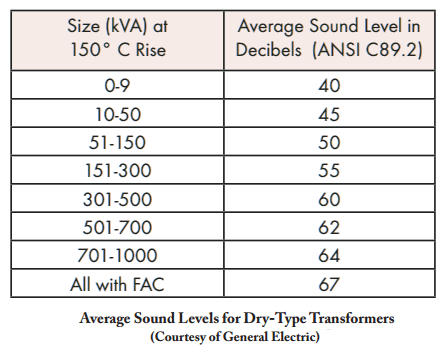
Average sound level of transformers per ANSI C89.2. Photo: General Electric.
Methods for reducing excessive noise in transformers
When transformers must be located in noise sensitive areas, precautions should be taken to avoid amplification of the transformer sound:
- Loosen anchor bolts between the transformer and enclosure and let the unit rest on the vibration pads only. (Except on certified seismic units.)
- Use flexible conduit and bus connections.
- Avoid mounting transformers on walls, balconies, and floors with low masses.
- Avoid uneven mounting surfaces.
To meet NEMA listed average sound levels, a transformer should be installed in a location where there is a 10-foot clearance on all sides except floor or ground. Units located in close proximity to hard surfaces may produce higher than average sound levels.
Install transformers in an area where the noise will be least objectionable. Avoid rooms where hard surfaces are in close proximity to the transformer. Use acoustic absorbing materials on walls, floors, and ceilings. Avoid installation of units in corners, hallways, and stairways, and near heating and air conditioning ducts.
References
- Power Dry II Dry Type Transformers – Square D
- Understanding Transformer Noise - Federal Pacific
- Causes and Effects of Transformer Sound Levels
